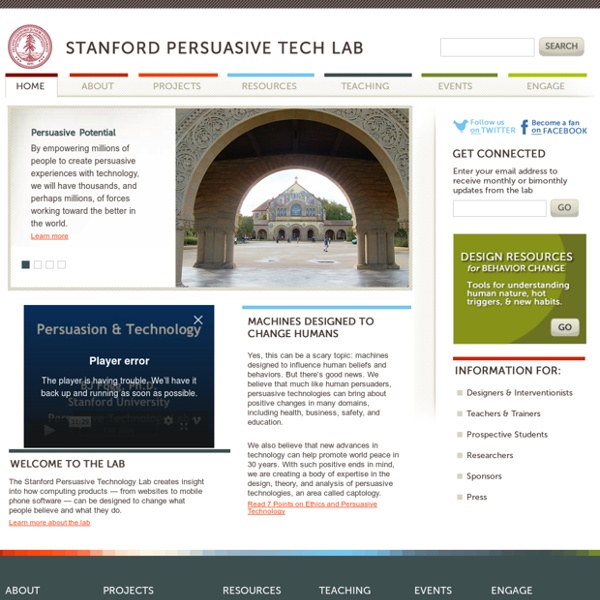



http://captology.stanford.edu/
Related: designGestalt Principles Applied in Design By Michael Tuck Web designers, like other artists and craftsmen, impose structure on the environment. We enforce order and beauty on the formless void that is our blank computer screen. We do it in different ways — creating an organized layout first, writing text and content first, or even basing a design concept on an image, a color palette, or something that visually trips your trigger, whether it’s a sunset or a Song Dynasty painting.
Brains in Silicon Welcome to Brains in Silicon. Learn about the lab, get to know the brains that work here, and find out about new projects that you could join. We have crafted two complementary objectives: To use existing knowledge of brain function in designing an affordable supercomputer—one that can itself serve as a tool to investigate brain function—feeding back and contributing to a fundamental, biological understanding of how the brain works. We model brains using an approach far more efficient than software simulation: We emulate the flow of ions directly with the flow of electrons—don't worry, on the outside it looks just like software. Welcome and enjoy your time here!
Safe search engines for kids? Reader Q+A at Cool Mom Tech What’s the best search engine for kids, in your experience? -via Twitter Keeping kids safe online should be a huge priority for parents. When it comes to kid-safe search, there are actually a lot of good options out there. 5 Reasons Why Metaphors Can Improve the User Experience There are many ways to experience the world around us. Especially offline, we can make use of our different senses to collect information, interpret our environment and make judgments. On the Web, however, our senses are more limited. As designers, we need to present information carefully to make sure our users think, feel and do the right thing. A great way to help your users understand abstract content, create a sense of familiarity, trigger emotions, draw attention and motivate action are metaphors. "The way we think, what we experience, and what we do every day is very much a matter of metaphor." - Lakoff and Johnson
Stanford University Stanford University (officially Leland Stanford Junior University) is a private research university in Stanford, California, and one of the world's most prestigious institutions,[8][9][10][11] with the top position in numerous surveys and measures in the United States.[12][13][14][15][16][17][18] Stanford was founded in 1885 by Leland Stanford, former governor of and U.S. senator from California and leading railroad tycoon, and his wife, Jane Lathrop Stanford, in memory of their only child, Leland Stanford, Jr., who had died of typhoid fever at age 15 the previous year. Stanford was opened on October 1, 1891[2][3] as a coeducational and non-denominational institution. Stanford is located in northern Silicon Valley near Palo Alto, California. Students compete in 36 varsity sports, and the University is one of two private institutions in the Division I FBS Pacific-12 Conference. History[edit]
12 Things Students Should Never Do on Social Media The last thing young people want is another set of rules. But these days, social media comes with great responsibility, whether you're just starting high school or finishing up college. The fact is, irresponsible social media conduct could potentially ruin your education and negatively impact your career, not to mention hurt others in the process.
Free Texture Download and Resources Link Textures is always a good stuff for a designer to spice out their work or masterpieces. So today, in this article I’d like to present a list of great high resolution free paper and other textures.I've been surfing the net yesterday and made some list for you.Some of them are from my bookmark. I also have pick some of the textures from deviant art. Download and use it for your next masterpiece! Use an adjustable monitor desk mount for better projection of graphic designs on your computer Center for the Study of Poverty and Inequality The Stanford Center on Poverty and Inequality (CPI), one of three National Poverty Centers, is a nonpartisan research center dedicated to monitoring trends in poverty and inequality, explaining what's driving those trends, and developing science-based policy on poverty and inequality. CPI supports research by new and established scholars, trains the next generation of scholars and policy analysts, and disseminates the very best research on poverty and inequality. The current economic climate makes CPI activities and research especially important. The following are a few critical poverty and inequality facts:
BEHAVIOR WIZARD – Persuasive Tech The Behavior Wizard is a method for matching target behaviors with solutions for achieving those behaviors. It is a systematic way of thinking about behavior change. The Behavior Wizard expands the Behavior Grid and the Behavior Model by combining our best work into one easy-to-use solution. Fogg Behavior Grid – 15 Ways Behavior Can Change How to Make Forms, Surveys, and Quizzes in Google Docs and Spreadsheets or Google Apps Want to find out what your coworkers want for lunch? Need to get feedback for your training session? Want to find out which movie your friends want to see on Saturday? Do you need a database of your club member's phone numbers? Use Google Forms.
Thoughts on Developing A Design Concept A good design begins with a good design concept. You’re trying to solve a problem and your concept will lead the way and give you direction for your design decisions. How do you form a concept? What questions do you need to ask in order to develop one? How does your concept become the roadmap for your design? Virtue Ethics 1. Preliminaries Virtue ethics' founding fathers are Plato and, more particularly Aristotle (its roots in Chinese philosophy are even more ancient) and it persisted as the dominant approach in Western moral philosophy until at least the Enlightenment. It suffered a momentary eclipse during the nineteenth century but re-emerged in the late 1950's in Anglo-American philosophy.